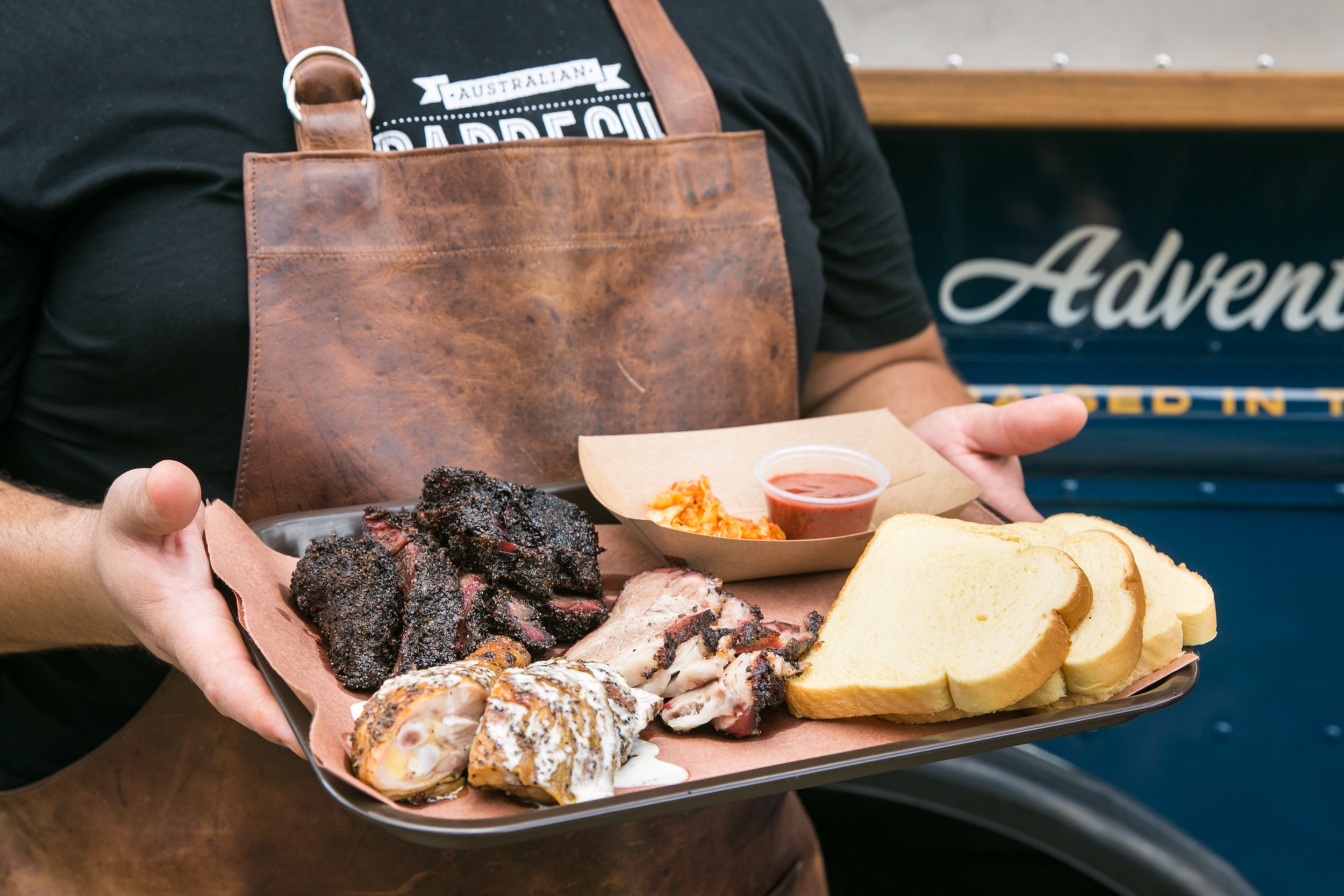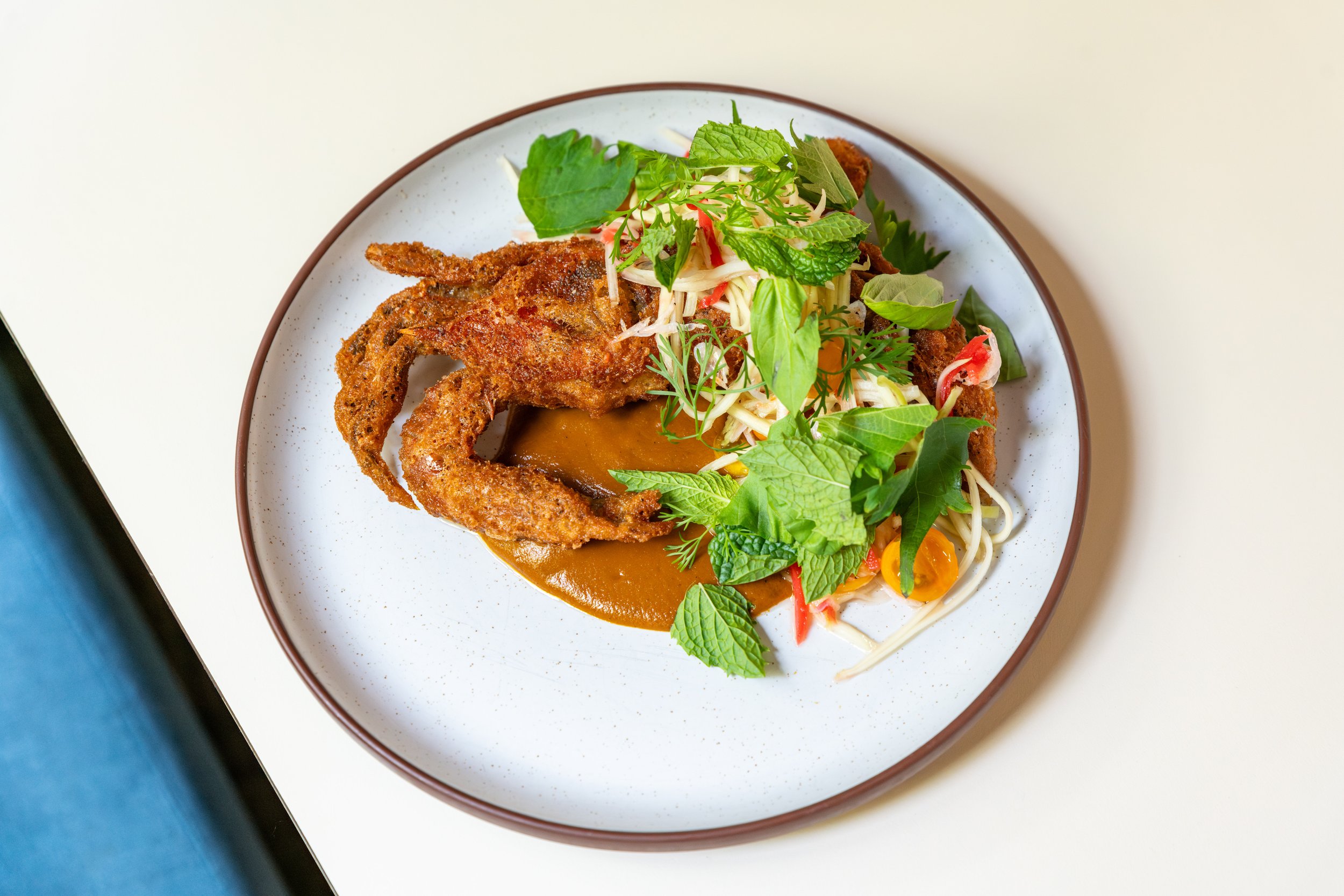Generation Smoke: New Opportunities and Voices in Texas Barbecue
Barbecue-obsessed Texas is making room for new faces and voices in the pits.
Pitmaster Esaul Ramos of 2m Barbecue Smokehouse
Esaul Ramos lives at 2M Barbecue Smokehouse Wednesday through Sunday, alternating overnight shifts with his business partner and childhood friend Joe Melig. There’s a small bed next to the smoker and a TV for company. The scent of brisket doesn’t leave his bones. 2M is a dream for Ramos. He grew up with South Texas backyard barbecue and a father who, more often than not, burned the meat. Having fallen in love with the craft, Ramos spent two years commuting from San Antonio to Austin to work for John Lewis at La Barbecue and eventuallytook over as head cook.
With little more than $5,000 and a lucky break on a lease,Ramos and Melig went from dreamers to small business owners and Texas Monthlyhyped pitmasters in barely a year. It turns out, as long as you can smoke meat, there’s now a space for you in Texas barbecue. “Aaron [Franklin] made it feel like it was possible,” says Ramos.
Franklin opened his first barbecue trailer during the food truck boom of 2009, and a brick and mortar in 2011. The lines, President Obama, journalists, and plaudits followed. Franklin has earned the no. 1 spot on Texas Monthly ’s definitive “Top 50 Barbecue Joints in Texas” list. He won a StarChefs Rising Stars Award, and he is the first-ever pitmaster to win a James Beard Award. All for brisket. Well, mostly for brisket. “He gave barbecue a new lease on life. It tasted a way that it’s never tasted before,” says Ramos.
Franklin’s namesake restaurant shifted meat gravity away from Lockhart, the barbecue capital of Texas, and suddenly a young Mexican-American or a classically trained chef or a curious server felt like he (or she!) had a chance to succeed at the craft.
Laura Loomis had never really eaten barbecue when she started as a server at Jason and Jake Dady’s Two Bros BBQ Market in San Antonio. Nine months in, Loomis decided she wanted to learn the pits, coming in on her days off and shadowing the crew until a position opened up. She filled it naturally and, over a year and a half, became pitmaster. “I’m a little female, and, at first, going from pit hand to pitmaster, the initial reception wasn’t the best,” says Loomis. “I had to fight to find a good crew.” Two years later, she has refined Two Bros. systems and locked down a solid team of pit hands, even if they’re “all dudes still.”
The Dadys opened Two Bros. in 2009, just as the restaurant community began to discover the potential of chef-driven casual dining. Two years later Jason Dady would close his 10-year old fine-dining restaurant, The Lodge. He wrote in a statement: “Fine dining is on life support and I don’t want to be here when it dies.” A few other national trends collided in the surrounding years. Wood-fired cooking became a national fixation, and chefs began moving from traditional kitchens into more focused crafts—butchery, brewing, charcuterie, and barbecue.
Chef training is as good as any other for diving into barbecue. Tim Rattray of The Granary ’Cue & Brew worked in Andrew Weissman’s kitchens in San Antonio, firstat Le Rev and Il Sogno, and then Sandbar as sous chef. When he saw a gap in the city’s barbecue market, he had a friend design and weld a pit. Rattray spent six months smoking meat in his backyard, often five nights a week, to learn the nuances of cooking with live fire. “All the kitchens I worked in, the cooking was pretty stable and predictable, using a gas burner or an oven. For me, cooking with fi re was really the draw.”
Two Bros BBQ | San Antonio, TX
Pitmaster Laura Loomis of Two Bros BBQ | San Antonio, TX Beef Brisket, Chicken Thighs, Cherry Glazed Baby Back Ribs, Smoked Sausage, Creamed Corn, Potato Salad, Bacon-wrapped Jalepeño Poppers
Unlike Rattray, who spend much of his upbringing in barbecue-barren England, Tom Micklethwait grew up in Austin immersed in barbecue culture. He smoked meats at home for fun while working at Vespaio, one of Austin’s pioneering chef-driven restaurants. After 10 years of backyard smoking, Micklethwait left the kitchen, bought a trailer, and opened Micklethwait Craft Meats in 2012.
Miguel Vidal worked in kitchens for 17 years, but barbecue goes even further back. “For every quinceañera, birthday party, or any excuse to get together, this is how my family cooks,” says Vidal, owner and pitmaster of Valentina’s Tex Mex BBQ in Austin. When he moved to Austin, the San Antonio native was unimpressed with the city’s Mexican food. “For Mexican-Americans, we end up in these categories of not being Mexican enough, and not American enough. Austin’s Tex Mex food wasn’t a real representation of our cuisine. We’ve always done barbecue, though. The Mexican influence has always been there.”
The Mexican influence at Valentina’s permeates every meat and dish. There are fresh salsas, chorizo, otherworldly charro beans, guacamole, and warm flour tortillas instead of white bread. On weekends, he often makes barbacoa—the quintessential Mexican-American smoked cow’s head or cheeks. “I knew if I were to do them together, the Mexican part had to be as good as Texan,” says Vidal. “Our barbecue had to be as good as anyone else’s.”
Ramos blends Central and South Texas styles at 2M. His brisket, turkey, and ribs refl ect his training at La Barbecue; serrano chile-Oaxaca cheese sausage and borracho beans, his upbringing. He too makes barbacoa, which along with fl our tortillas and Big Red (a fluorescent soda unpalatable to outsiders), makes up the trinity of Sundays in San Antonio.
Barbecue in Texas has all kinds of accents these days— and they’re beloved as long as you get the meat right. “If you can’t do brisket or ribs and if you’re not making your own sausage, you’re not going to survive,” says Evan LeRoy, who started his career at New York City’s Hill Country Barbecue before returning home to Austin to run the Central Texas-style program at Freedmen’s. When he had the chance to open his own spot, he didn’t want to be defined by Central Texas brisket alone. “I don’t want to cook brisket every day,” he says. “People are genuinely happy to get something different on their plates.” In addition to barbacoa-inspired cheeks, he sells chicken with a sacrilegiously mayonnaise-based Alabama white sauce, and sides like a refreshing watermelon-fennel salad.
Rattray, accustomed to innovation in his previous kitchen life, couldn’t bear to keep his menu static either. “The more I kept staring at a fi rebox for hours a time, the more I thought of where I came from. Why can’t we use old techniques with progressive flavors?” he says.
Even Aaron Franklin is expanding his repertoire with Loro, a partnership with Tyson Cole’s Hai Hospitality. Cole’s vision of an Asian smokehouse has been churning for years. “We want to change the game and make the sides amazing. It’s all about the acid and the barbecue sauce. [Aaron] will stick with post oak for smoking, but he wants to play,” says Cole. “And he has a great organization now to help.”
Teaching, training, sharing. That’s the real story of barbecue right now. When Aaron Franklin started out, he lamented his “30-hour work days.” Like Ramos, there were stretches when he couldn’t leave the restaurant. Now, he has a team who can help expand Franklin’s vision—and Texas’s understanding—of barbecue. Jason Dady took a chance on Laura Loomis. LeRoy found a barbecue mentor in New York, of all places. There’s a barbecue community now, one outside the competition circuit and Hill Country royalty, that doesn’t hold all its secrets close. It’s ready to expand and accept newcomers, so long as they put in the sweat and time to get their brisket right.
Pitmaster Evan LeRoy of LeRoy & Lewis | Austin, TX 44 Farms Beef Cheeks, Peaceful Pork Sliced Shoulder, and Cobb Creek Chicken and Alabama White Sauce
Pitmaster Tom Micklethwait of Micklethwait Craft Meats | Austin, TX Brisket; Knockwurst; Pork Ribs; Sides: Campfire Beans, Jalapeño-Cheese Grits, and White Bread
So You Want to Barbecue:
Costs to Consider Smoker: In Texas, at least, most operations employ off-set smokers. If you know how to weld, you can build them yourself, or spend around $14k for a used smoker or $25k to $37k for new. Gas and electric smokers aren’t popular in these parts, but they are efficient and will set you back $4k (used and small) to $32k (new and deluxe).
Meat: After paying around $10 per pound for brisket—most pitmasters use certifi ed Angus beef—you lose 40 percent to 50 percent on the smoker. Micklethwait’s protein food costs are 30 percent to 35 percent. “It’s more like a retail mark-up—not exactly like food service,” he says.
The Learning Curve: You will ruin meat until you don’t, which means you’ll have to buy meat until you can perfect it, or work for someone who believes in you enough to let you burn barbecue. “I’d be lying if I said I’ve never charred a brisket or overcooked a turkey. The biggest thing for me was time, getting into the pit and doing,” says Loomis.
Wood: Post oak is king in Texas. Depending on the volume, it’s easy to blow through $300 to $1,200 of wood a week.
Labor: The romantic idea of a lone pitmaster with closely guarded secrets just isn’t true, or possible if you want to run a functional business. As with a restaurant, you must hire a crew. Micklethwait has eight people on staff to run his pits and trailer. Loomis has a team of four, on the pits alone.
Opening: You can open a barbecue joint for a lot less than a traditional restaurant if you’re down for a trailer or a concrete box counter-service spot. Opening funds in Austin and San Antonio ranged from an unimaginable $5,000 to $50,000. “Trucks are an easy, cheap way to open,” says LeRoy.
Commissary Space: If you go the truck or trailer route, you’ll need commissary space to store fresh ingredients and prep side dishes.











